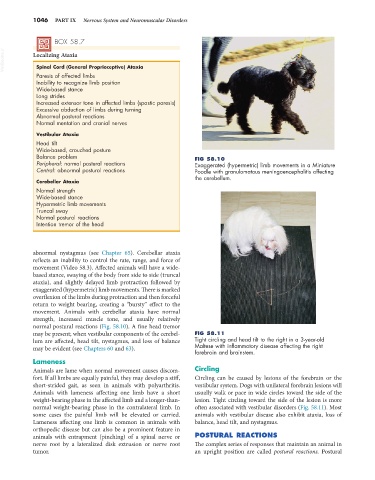Page 1074 - Small Animal Internal Medicine, 6th Edition
P. 1074
1046 PART IX Nervous System and Neuromuscular Disorders
BOX 58.7
VetBooks.ir Localizing Ataxia
Spinal Cord (General Proprioceptive) Ataxia
Paresis of affected limbs
Inability to recognize limb position
Wide-based stance
Long strides
Increased extensor tone in affected limbs (spastic paresis)
Excessive abduction of limbs during turning
Abnormal postural reactions
Normal mentation and cranial nerves
Vestibular Ataxia
Head tilt
Wide-based, crouched posture
Balance problem FIG 58.10
Peripheral: normal postural reactions Exaggerated (hypermetric) limb movements in a Miniature
Central: abnormal postural reactions Poodle with granulomatous meningoencephalitis affecting
the cerebellum.
Cerebellar Ataxia
Normal strength
Wide-based stance
Hypermetric limb movements
Truncal sway
Normal postural reactions
Intention tremor of the head
abnormal nystagmus (see Chapter 65). Cerebellar ataxia
reflects an inability to control the rate, range, and force of
movement (Video 58.3). Affected animals will have a wide-
based stance, swaying of the body from side to side (truncal
ataxia), and slightly delayed limb protraction followed by
exaggerated (hypermetric) limb movements. There is marked
overflexion of the limbs during protraction and then forceful
return to weight bearing, creating a “bursty” effect to the
movement. Animals with cerebellar ataxia have normal
strength, increased muscle tone, and usually relatively
normal postural reactions (Fig. 58.10). A fine head tremor
may be present; when vestibular components of the cerebel- FIG 58.11
lum are affected, head tilt, nystagmus, and loss of balance Tight circling and head tilt to the right in a 3-year-old
may be evident (see Chapters 60 and 63). Maltese with inflammatory disease affecting the right
forebrain and brainstem.
Lameness
Animals are lame when normal movement causes discom- Circling
fort. If all limbs are equally painful, they may develop a stiff, Circling can be caused by lesions of the forebrain or the
short-strided gait, as seen in animals with polyarthritis. vestibular system. Dogs with unilateral forebrain lesions will
Animals with lameness affecting one limb have a short usually walk or pace in wide circles toward the side of the
weight-bearing phase in the affected limb and a longer-than- lesion. Tight circling toward the side of the lesion is more
normal weight-bearing phase in the contralateral limb. In often associated with vestibular disorders (Fig. 58.11). Most
some cases the painful limb will be elevated or carried. animals with vestibular disease also exhibit ataxia, loss of
Lameness affecting one limb is common in animals with balance, head tilt, and nystagmus.
orthopedic disease but can also be a prominent feature in
animals with entrapment (pinching) of a spinal nerve or POSTURAL REACTIONS
nerve root by a lateralized disk extrusion or nerve root The complex series of responses that maintain an animal in
tumor. an upright position are called postural reactions. Postural

